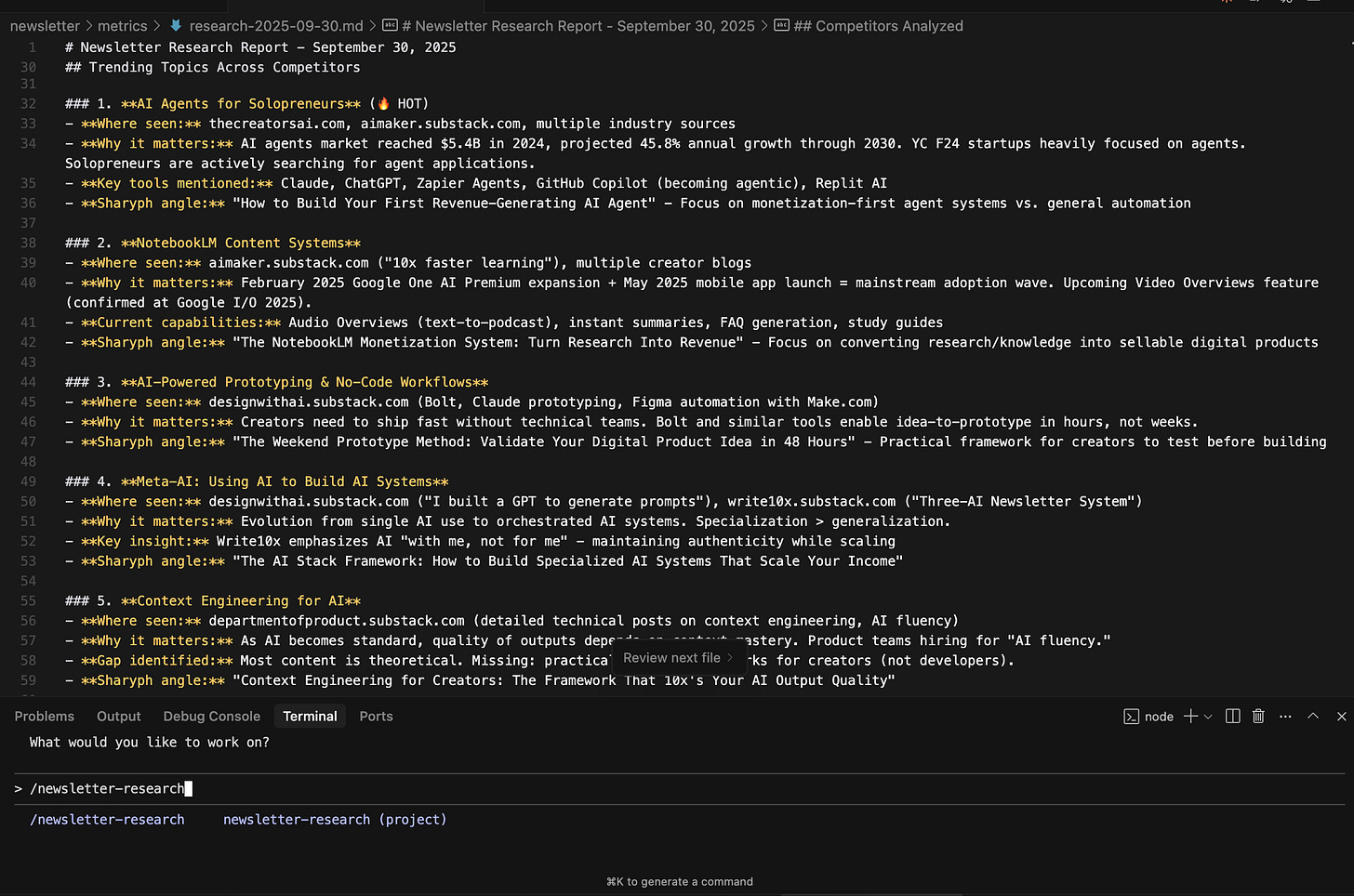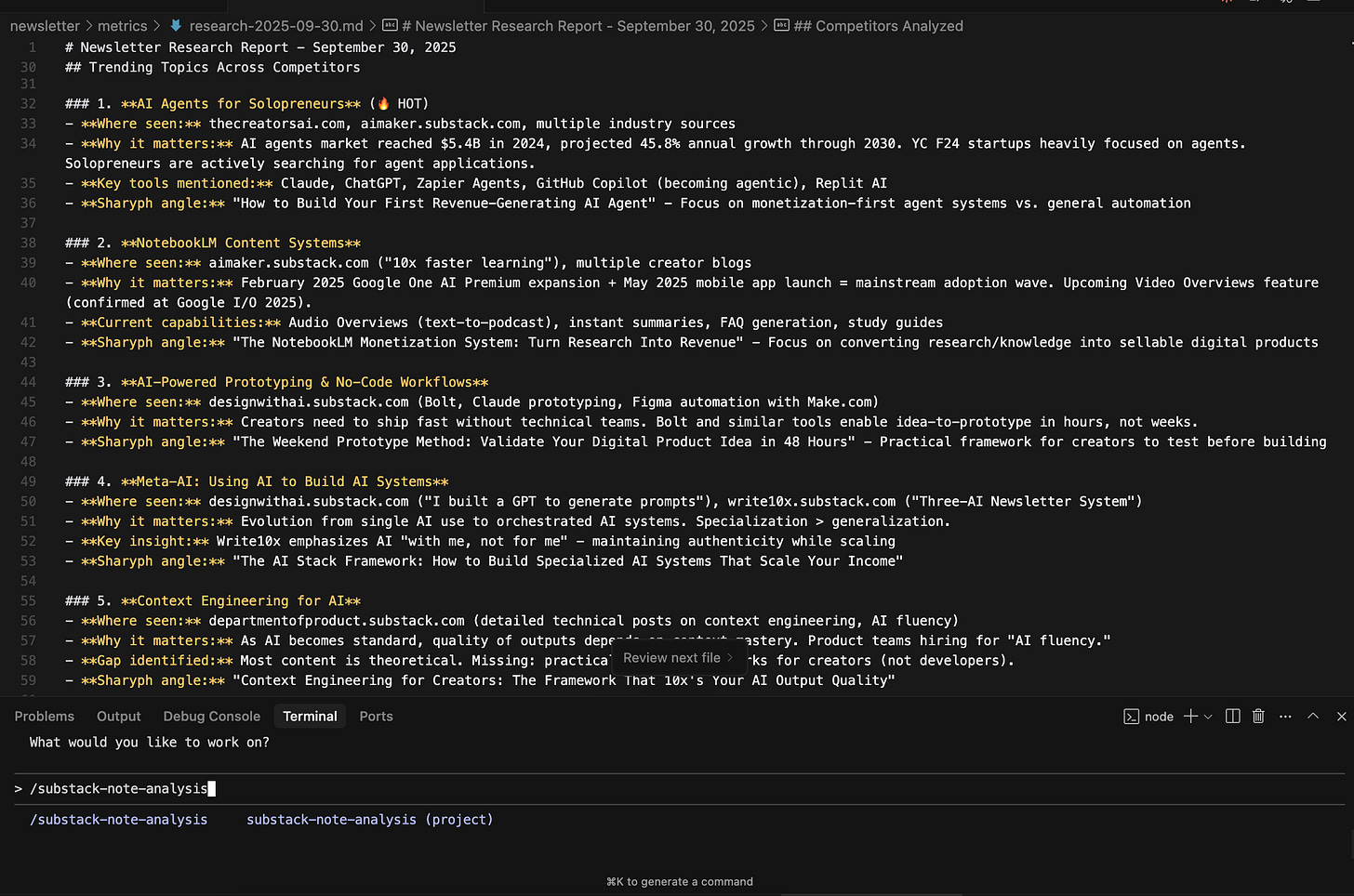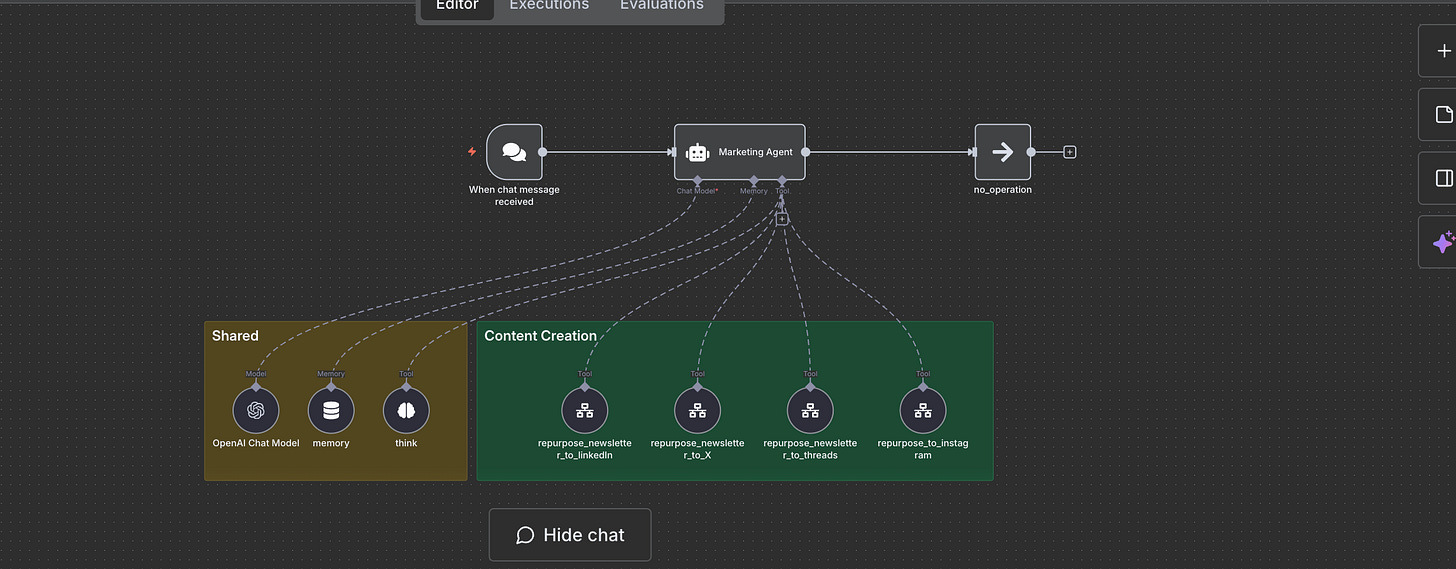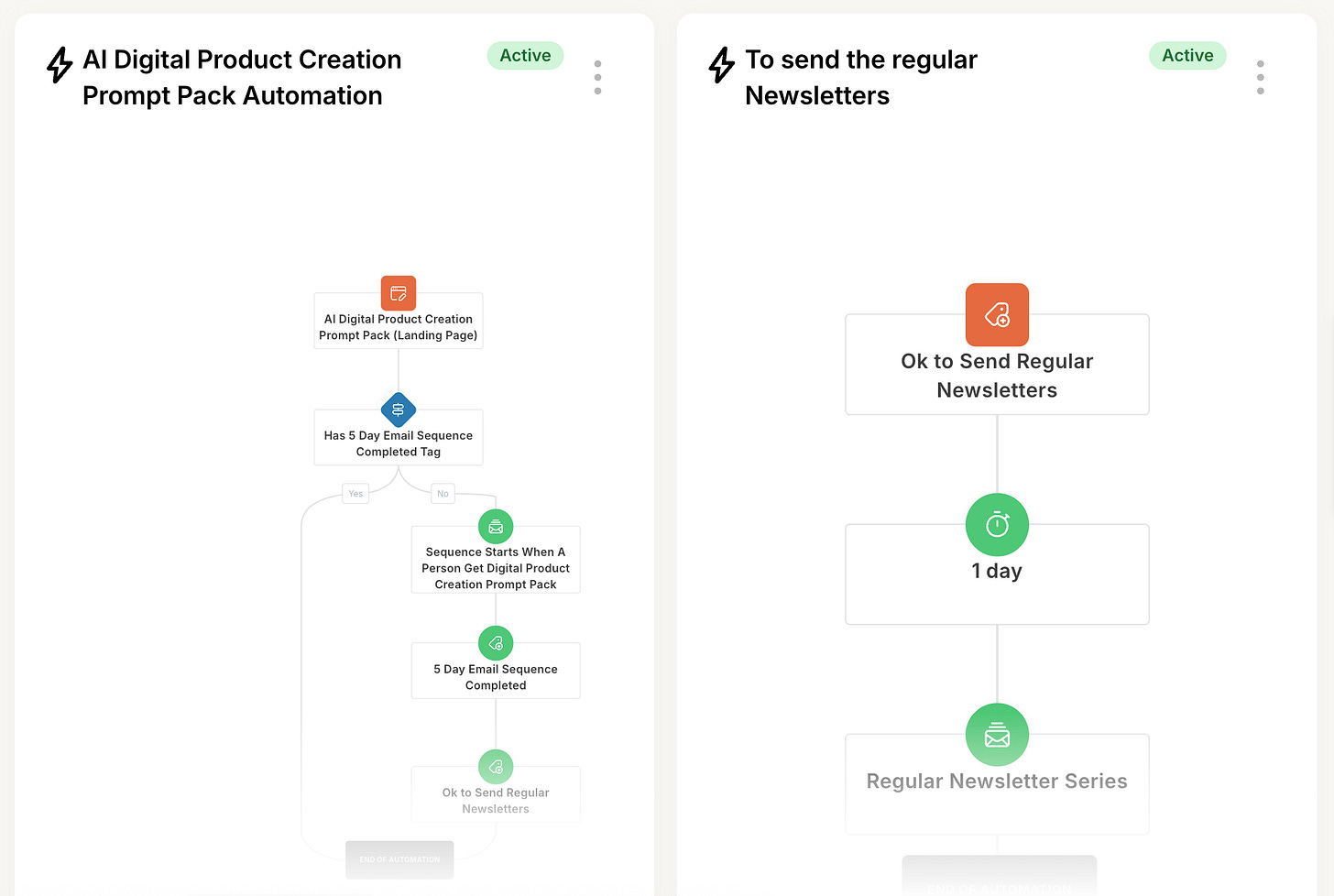Two years ago, I had 21 software subscriptions.
Slack for communication. Notion for notes. Asana for tasks. ClickUp for projects. Three different AI tools. Multiple analytics platforms. Email tools. Calendar apps. Social media schedulers. The list went on.
My monthly SaaS bill? $340.
My productivity? Average at best.
My focus? Scattered across a dozen browser tabs and notifications.
Here’s the kicker: Today, my monthly cost? $88 maximum. My productivity? Through the roof. My mental clarity? Finally restored.
And no, I didn’t sacrifice capabilities. I didn’t cut corners. I didn’t go back to spreadsheets and manual processes.
I just got smart about what actually moves the needle.
Here’s the math that changed everything: $3,000+ saved annually. 15+ hours reclaimed each month. Zero tool overwhelm.
Research shows that 59% of creators now use AI to streamline their workflows. But most are still drowning in subscriptions, juggling platforms, and burning hours just managing their “productivity” stack.
Let me show you how I deleted 21 tools, kept the three that matter, and watched my revenue climb while my stress plummeted.
The Tool Trap (And Why We All Fall Into It)
Here’s what nobody tells you about productivity tools:
More tools doesn’t mean more productive.
It means more context switching.
More logins to remember.
More integrations to manage.
More time spent being “productive” instead of actually producing.
I learned this the hard way.
Every time I hit a bottleneck in my business, my first instinct was the same: “There’s probably a tool for that.”
Need better project visibility? Add Asana.
Want to track time? Add Toggl.
Need team communication? Add Slack.
Want deeper analytics? Add three different tracking platforms.
Each tool came with a promise. Each one seemed essential. And each one added another layer to what I now call “tool debt.”
The Hidden Cost of Tool Debt
Tool debt is like technical debt, but worse. It’s the accumulated cost of every tool you’ve added to your stack:
Learning curve - Hours spent watching tutorials and reading docs
Maintenance overhead - Updating settings, managing permissions, handling changes
Integration work - Getting tools to talk to each other (and fixing them when they break)
Subscription management - Tracking renewals, comparing plans, justifying costs
Context switching - The mental tax of jumping between platforms
Here’s the stat that woke me up: Research shows that 95% of companies see no measurable ROI from their tool investments, despite AI and automation adoption doubling in the last two years.
Think about that.
Everyone’s buying tools.
Almost nobody’s seeing returns.
My Breaking Point
I was trying to write a newsletter. Simple task, right? But first, I had to:
Check Notion for my content calendar.
Jump to Evernote for my research notes.
Open three Chrome tabs with saved articles.
Switch to my writing tool.
Reference my audience insights in another analytics platform.
Twenty-three minutes passed before I wrote a single word.
That’s when I audited everything.
Every tool. Every subscription. Every login.
The results shocked me: 80% of my business value came from just 20% of my tools.
The other 80%? Noise.
Complexity. Overhead.
The Decision That Changed Everything
I made a rule that day, and I’ve stuck to it ever since:
If a tool doesn’t directly generate revenue or save me at least 5 hours per month, it’s gone.
No exceptions. No “but I might need it someday.” No “it was only $10/month.”
Gone.
That’s how I went from 21 tools to 3.
And how my business went from scattered to streamlined.
Let me show you what stayed…and why.
My 3-Tool Business Stack
Let me introduce you to the three tools that run my entire business.
No bloat. No overlap. No wasted subscriptions.
Just 3 tools, each with a clear job, each earning its place every single month.
Tool #1: Claude (My AI Partner) - $20/month
This is my secret weapon. And I’m not exaggerating when I say it replaced eight different tools.
What Claude actually does for me:
Content Creation Engine:
I draft newsletters, social posts…etc in a fraction of the time.
I’m not talking about AI writing everything while I sit back. I’m talking about AI doing the heavy lifting on structure, research synthesis, and first drafts while I add strategy and personality.
Today I do my content research month, with just “/newsletter-research”
Research for Social Media (Sustack/X/Linkedin) Content:
Remember those three tabs of saved articles I mentioned? Now I drop them into Claude Code.
It replaces Pocket, Evernote, and every “read later” service I ever paid for.
With Claude Code, I just have to send “/substack-note-analysis” to start analysing to create content for Substack as Notes.
Strategic Thinking Partner
Stuck on a business decision? Unclear about positioning? I use Claude to think through problems. It asks questions I haven’t considered. It challenges my assumptions. It’s like having a business consultant on retainer.
Here’s the ROI that matters: Claude saves me 10 hours per week on content analysis/creation alone.
At my hourly rate of $100+, that’s $4,000+ per month in time value for a $20 subscription.
That’s a 200:1 return on investment.
The best part?
I know Claude inside-out now. I understand its strengths, its limitations, how to prompt it effectively. That depth creates capabilities that most people…jumping between multiple AI tools…never develop.
Tool #2: n8n (My Automation Hub) - $24/month (or $0 self-hosted)
If Claude is my brain, n8n is my nervous system.
It’s the automation platform that runs silently in the background, connecting everything and making sure my business operates even when I’m offline.
And here’s the beautiful part: It replaced seven different tools that were costing me $100+ per month combined.
Why n8n instead of Zapier or Make?
Simple: n8n doesn’t charge per step or execution like Zapier does. I have unlimited workflows. I can build as complex as I need without watching a meter tick up.
Plus, it has AI agent capabilities built in…meaning I can have AI make decisions within my workflows. And if I wanted, I could self-host it for $0/month (though I use the cloud version for convenience).
My Core Workflows That Run on Autopilot:
Content Repurposing Engine—I write one newsletter. n8n takes that content and automatically transforms it into:
LinkedIn posts (optimized for LinkedIn’s platform)
X threads (broken into engaging tweet sequences)
Individual tweets (punchy, standalone ideas)
Substack Notes (quick-hit insights for my community)
What used to take me 4-5 hours of manual reformatting now happens in minutes. One piece of content, four platforms, zero extra work.
Here’s what this means in practice: 90% of my operational workflows run automatically.
No manual data entry.
Everything just... works.
The ROI: This automation saves me at least 20 hours per month on operations and follow-up.
That’s $2,000+ in monthly time value for a $24 subscription.
A 50:1 return on investment.
But here’s the deeper win: Mental freedom.
I’m not wondering if I remembered to send that email. I’m not manually copying data between platforms. I’m not staying up late trying to “catch up” on operations.
The business runs. I build.
Tool #3: Kit (My Email Hub) - $15/month
This is the revenue engine. The core infrastructure. The tool that directly generates income.
Kit isn’t just an email service provider. It’s my entire email-based business platform…and it replaced five different tools I was paying for separately.
Gone: Separate email service. Landing page builder. Simple website platform. Payment processor. Complex analytics suite.
What Kit handles for my business:
Newsletter Publishing - Unlimited emails to my list. Clean, simple interface. Reliable delivery. That’s the foundation.
Email Automation & Sequences - Welcome sequences, product delivery, re-engagement campaigns…all automated. Set it once, it runs forever.
Landing Pages & Lead Magnets - Every lead magnet has a landing page. Every product has a sales page. Built right in Kit. No separate page builder needed.
Payment Processing - Kit Commerce handles all my digital product sales. Someone buys → they get instant access → they’re added to the right sequences. All in one place.
Analytics That Matter - I don’t need Google Analytics rabbit holes. Kit shows me open rates, click rates, and conversion rates. That’s all I need to optimize.
The ROI: Kit is my direct revenue generator.
It handles all email marketing, product delivery, and payments for my business.
At $39/month, that’s a 150:1+ return on investment.
(right now price is $15/month, low tir..but they are increasing the price on Nov, so I am using $39/month as the price from now on)
But beyond the numbers, here’s what matters: Kit is reliable.
I don’t worry about deliverability. I don’t stress about payment processing. I don’t wonder if my automation will fire.
It just works. Every time.
Total Stack Overview:
Claude: $20/month (AI partner)
n8n: $24/month (automation hub)
Kit: $39/month (email & revenue engine)
Total monthly cost: $83/month
Previous cost with 21 tools: $340/month
Annual savings: $3,084
Time saved: 15+ hours/month
Mental clarity: Priceless
Three tools. One focused business. Zero overwhelm.
The Rule That Governs Everything:
If I can’t explain how a tool directly generates revenue or saves me 5+ hours per month, it doesn’t make the cut.
No exceptions.
No “but it’s only $10/month.”
No “I might need it someday.”
Every tool in my stack earns its place. Every single month.
This clarity is what separates a lean, profitable creator business from a bloated, overwhelmed one.
My Framework for Adding New Tools
Neve forget this…You’ll be tempted to add tools.
A new automation platform launches. A friend recommends their favorite productivity app. You see a tool demo that looks incredible.
The urge to add “just one more” will hit you.
When it does, run it through this framework. It’s saved me from dozens of bad decisions.
My 4-Questions Before Considering any Tool:
Before adding ANY tool to my stack, it must pass all four questions:
Question 1: What am I replacing?
A new tool must eliminate an existing tool or manual process. No additions without subtractions.
If you’re adding n8n, what are you removing? If you’re adding Claude, what subscriptions are you canceling?
New tool = replacement, not expansion.
Question 2: What’s the ROI in 6 months?
Do the math. Be specific.
Calculate either:
Time saved × your hourly rate = monthly value
Direct revenue generated = monthly value
Then multiply by 6 months. Compare that to 6 months of subscription cost.
If the ROI isn’t at least 10:1, it’s not worth the complexity it adds.
Question 3: Can one of my existing 3 tools do this?
This is the question that stops me most often.
Usually, the answer is yes…I just haven’t explored the tool deeply enough.
Claude can do more with better prompts. n8n has features I haven’t tried. Kit has capabilities I’m not using.
Before adding tool #4, master tools #1-3.
Question 4: Am I solving a real problem or procrastinating?
Be brutally honest here.
Is this tool actually the bottleneck? Or are you avoiding the hard work of building, shipping, and selling?
Sometimes “researching tools” is just productive procrastination. The work that matters is content creation, audience building, and product development.
Tools support that work. They don’t replace it.
If it doesn’t pass all four questions, don’t add it.
Period.
This framework has saved me thousands of dollars and countless hours. It’s kept my stack lean, my focus sharp, and my business moving forward.
The goal isn’t to have the perfect tool stack. The goal is to have the right tools…and know them so well they become invisible.
Your Action Plan (Practical Steps)
Here’s exactly how to simplify your tool stack and reclaim your focus:
Step 1: Audit
Make a complete list of every software subscription you have. Every. Single. One.
Then, for each tool, check your actual login frequency over the last 30 days. Be honest with yourself.
Last logged in: 2 days ago → Keep evaluating
Last logged in: 2 weeks ago → Probably not essential
Last logged in: 2 months ago → Why are you paying for this?
Most people discover they’re paying for 5-10 tools they haven’t touched in months.
Step 2: Calculate the Real Cost
Take your monthly SaaS bill and multiply by 12.
That’s your annual tool expense.
Now ask yourself: Is this investment generating returns?
For each tool, can you point to specific revenue it generated or hours it saved? If you can’t, it’s probably dead weight.
My $340/month tool habit was costing me $4,080 per year. And I couldn’t justify the ROI on 80% of it.
Step 3: Identify Your 80/20
Which 3-5 tools drive 80% of your business value?
Find your core three. The tools you couldn’t run your business without. The ones that directly contribute to revenue or save significant time.
Those are your keepers.
Step 4: Run a 30-Day Experiment
Here’s where it gets real.
Pick 5 underused tools. Cancel them. Track if you actually miss them.
(Spoiler: You probably won’t.)
Most tools we think are “essential” turn out to be optional when we actually test life without them.
Give yourself permission to cancel. Worst case? You re-subscribe in 30 days. Best case? You save thousands and gain clarity.
Step 5: Build Depth, Not Width
Once you’ve trimmed to your core tools, resist the urge to add more.
Instead, go deeper with what you have.
Ask yourself:
“What can Claude do that I haven’t explored?”
“What n8n features am I not using?”
“How can I use Kit more effectively?”
Watch tutorials. Read documentation. Experiment with advanced features.
The goal isn’t to have every tool. The goal is to master the right tools.
Most creators are one audit away from reclaiming 10+ hours per month and saving thousands per year.
The tools aren’t the problem. The tool debt is.
Cut the debt. Keep the essentials. Build the business.
Heads up:
Do you want me to sit with you and audit your business?
The Bigger Picture
The real win here isn’t just saving $3,000 per year.
It’s not even reclaiming 15+ hours per month.
It’s about reclaiming your focus and mental bandwidth.
In 2025, 43% of six-figure creators use AI tools weekly, and 59% use AI to streamline their entire workflow. They’re leveraging technology to build faster and smarter.
But here’s the paradox: while adoption is up, most are also drowning in subscriptions.
Research shows that 95% of companies see no ROI from their tool investments despite mass adoption. They’re buying everything, mastering nothing, and wondering why productivity hasn’t increased.
You have a different opportunity.
While others add complexity, you can simplify and win.
While they’re managing 20+ tools, you’re mastering 3.
While they’re troubleshooting integrations, you’re building products.
Remember This
You’re not just a content creator. You’re a business owner.
And business owners make strategic decisions about where to invest time and money.
Every tool in your stack should earn its place. Every dollar spent should have a return. Every hour saved should compound into more value created.
This isn’t about being cheap. It’s about being intentional.
It’s about building a business that serves your life, not one that steals it.
The three-tool stack isn’t a limitation. It’s liberation.
Three tools. Clear roles. Mastered capabilities. Compounding returns.
That’s how you build a lean, profitable creator business in 2025.
Ready to Build Your Lean Creator Business?
If this resonates with you, I can help you build your own streamlined, profitable creator business:
The Digital Creator Blueprint
1:1 consulting to clarify your offer, define your audience, and build a content system that actually converts. Includes offer crafting, brand positioning, 30-60 day content plan, and 2 follow-up calls.
This is for you if: You know you have valuable skills but you’re unclear on what to sell or how to position it.
Premium Membership
Get access to ALL my current and future digital products:
Twitter Success Mastery
AI SEO Playbook
From Skill to Sale (Notion course)
Plus everything I create going forward
This is for you if: You want the frameworks, templates, and systems without the 1:1 price tag.
One last thing:
I am creating an AI Agent System Creators. If you have a product, an audinece (1,000+ subs at least), send me a message, I would love to help you to automate from researching to creating content on social media.
Have a nice day! Tc
— Sharyph








Gold!